Chinese analogues of Soviet, American and Israeli drones
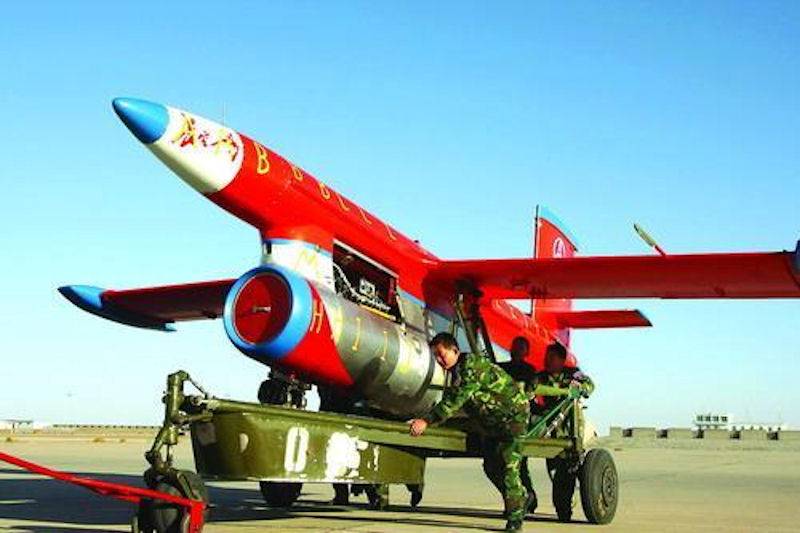
The first Chinese UAVs, which entered service in the early 1970s, were intended for training anti-aircraft artillery crews and were the simplest radio-controlled models with a piston motor and a plywood airframe, known as the Ba-2 and Ba-7. Their launch was carried out by solid-fuel boosters from a towed launcher.
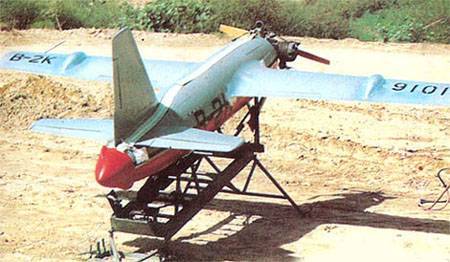
Radio-controlled target Va-2
These very primitive vehicles were followed by Chinese copies of the Soviet La-17 radio-controlled jet target and the American AQM-34N Firebee reconnaissance jet.
After the normalization of relations with the United States, the development of Chinese drones cooperation with Israel had a great influence. China's access to Israeli technology became possible in the early 1980s, after the Chinese leadership began to make sharp anti-Soviet statements, as well as provide significant military and financial support to the Afghan Mujahideen.
In this regard, China began to be considered by Western countries as a possible ally in the event of a military conflict with the USSR. To modernize the Chinese army, equipped with Soviet-style equipment and weapons developed in the 1950s and 1960s, with the blessing of the United States, a number of Western countries began military-technical cooperation with the PRC.
As a result, Chinese developers gained access to modern "dual-use products" at that time: avionics, aviation engines, means of communication and telecontrol.
At the first stage, Chinese designers were engaged in direct copying of Israeli drones or used components or equipment purchased in Israel. But after the aviation and radio-electronic industry of the PRC reached a high level of development, the situation changed. Many Chinese UAVs built in the XNUMXst century bear a strong resemblance to American reconnaissance and attack UAVs, but despite their superficial similarities, they are mostly designed by Chinese engineers.
Unmanned target SK-1
In the late 1950s, the Soviet Union handed over to the PRC several La-17M radio-controlled jet targets. Already after relations with the USSR deteriorated, the Nanjing Institute of Aeronautics began to create its own analogue. To do this, the La-17M was disassembled for detailed study. Externally, the Chinese radio-controlled UAV, named SK-1 (ChangKong-1), differed little from the Soviet prototype, but taking into account the technological capabilities of the Chinese industry, changes were made to its design.
The WP-1 turbojet engine with a thrust of 6 kN was installed on the SK-24,5 unmanned vehicle, which is also used on the J-6 (MiG-19) fighter. Depending on the modification, the weight of the empty UAV was 2–100 kg. Fuel capacity: 2–500 kg. Flight duration: 600–840 min. Speed: 45–70 km/h. Ceiling - up to 850 m. Like the later modifications of the La-910, the Chinese device was launched from a towed launcher using powder boosters.
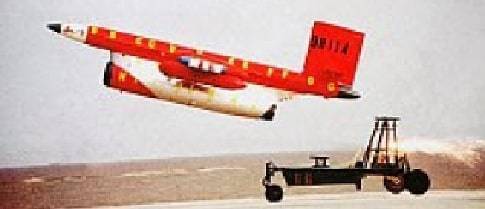
The first flight of the SK-1 UAV took place at the end of 1966. But due to the industrial decline caused by the “cultural revolution” that began in the PRC, the progress of work was greatly slowed down, and mass production of the modified SK-1A model began only in 1976.
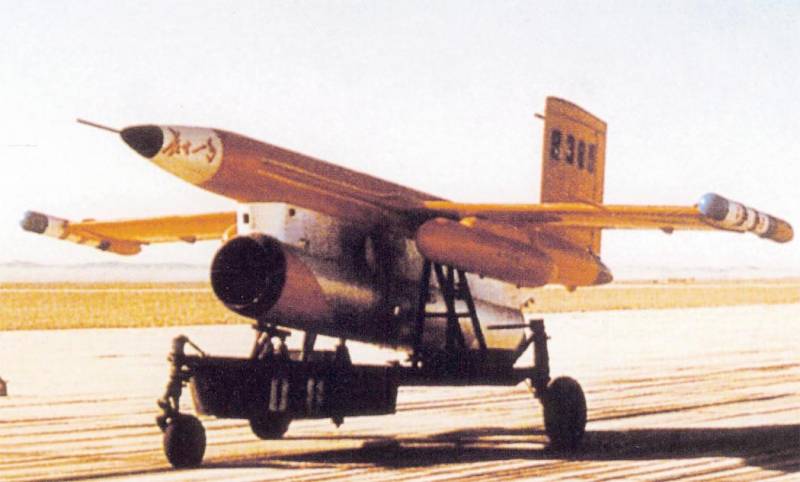
Unmanned jet target SK-1A
In addition to training calculations for the HQ-2 air defense system (Chinese version of the S-75) and testing new anti-aircraft missiles, a modification of the SK-1V was created for sampling during nuclear tests. This unmanned vehicle was used for the first time in "combat conditions" at the Lop Nor test site in 1978, putting an end to the practice of using manned aircraft to perform missions to take samples from a nuclear explosion cloud.
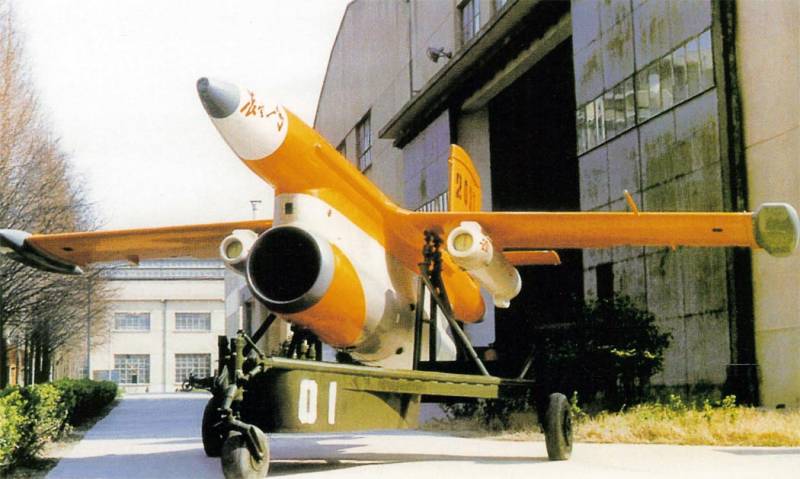
UAV SK-1V
In the 1980s, several new modifications entered service. The SK-1S UAV was adapted for low-altitude flights and was intended to simulate aircraft and cruise missiles breaking through at low altitude. The SK-1E had maneuverability comparable to the J-7 fighter (copy of the MiG-21).
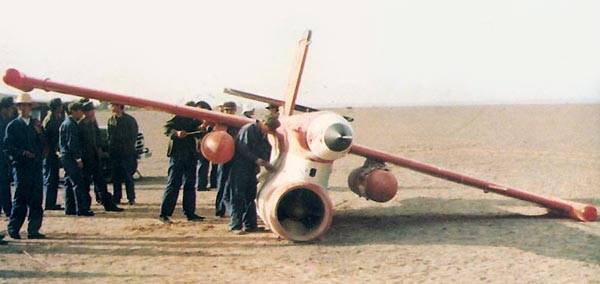
In 1995, the SK-2 supersonic UAV, based on the SK-1, was tested. This model had a swept wing and a more powerful turbojet engine equipped with an afterburner. The radio-controlled unmanned vehicle was intended for testing new anti-aircraft and aircraft missiles, but was not built in a large series. In the second half of the 1990s, the PLA Air Force developed a large surplus of obsolete supersonic J-6 fighters, which were mainly converted into unmanned targets.
Long-range unmanned reconnaissance aircraft WZ-5
In the late 1960s and early 1970s, several American AQM-34 Firebee reconnaissance unmanned aerial vehicles in varying degrees of safety were at the disposal of Chinese specialists. These drones were very widely used by the US Air Force during the fighting in Southeast Asia for conducting photo and electronic intelligence. In reconnaissance flights over North Vietnam, Laos, Cambodia and the southern regions of the PRC, more than 1 American Firebees were involved, making 000 sorties. At the same time, only the calculations of the SA-3M air defense system "landed" 435 UAVs. More than 75 drones were shot down by PLA fighters near the Sino-Vietnamese border.
In total, the US Air Force lost about 600 AQM-34 Firebees during the war. Some of the downed drones landed on treetops and received minor damage, which made it possible to study them in detail.
The creation of a Chinese clone of the AQM-34, designated WZ-5, began in the early 1970s at the Beijing University of Aeronautics Astronautics (BUAA). The testing of the first flight model began in 1972. However, the refinement of the prototypes was delayed, and the drone entered service only in 1981.
However, according to Western intelligence, the prototype WZ-5 UAV was used by the PLA Air Force during the Sino-Vietnamese conflict in 1979. According to American experts, the delay in adopting the drone is due to the inability of the Chinese industry to create a full-fledged analogue of intelligence and control equipment. Also, certain difficulties were associated with copying the Teledyne-Ryan CAE J69-T-41A compact turbojet engine.
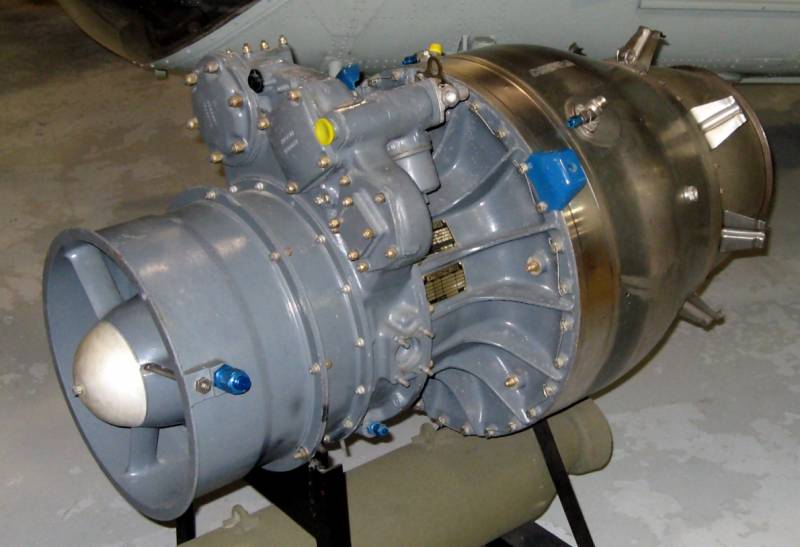
TRD Teledyne-Ryan CAE J69
An engine weighing 163 kg developed a thrust of 400 kgf. In China, this turbojet engine was produced under the designation WP-11. Subsequently, in addition to the WZ-5 UAV, such engines were installed on the HY-4 and HY-41 anti-ship cruise missiles.
American AQM-34 Firebee UAVs were launched from ground installations or specially modified C-130 Hercules turboprop aircraft. In the case of an air launch, the drone could be delivered to the border of the area where it was supposed to work, which, compared with the launch from a ground-based towed installation, significantly increased the duration of the flight over enemy territory.
Chinese experts converted several Tu-5 long-range bombers into WZ-4 UAV carriers. In the 1950s, China received 25 Tu-4 aircraft. The Tu-4 piston bomber, created on the basis of the American Boeing B-29 Superfortress, was considered in China as a strategic carrier of nuclear weapons. weapons and a platform for AWACS aircraft. Due to the lack of other aircraft of a similar class, the biography of a seemingly hopelessly outdated bomber turned out to be unexpectedly long.
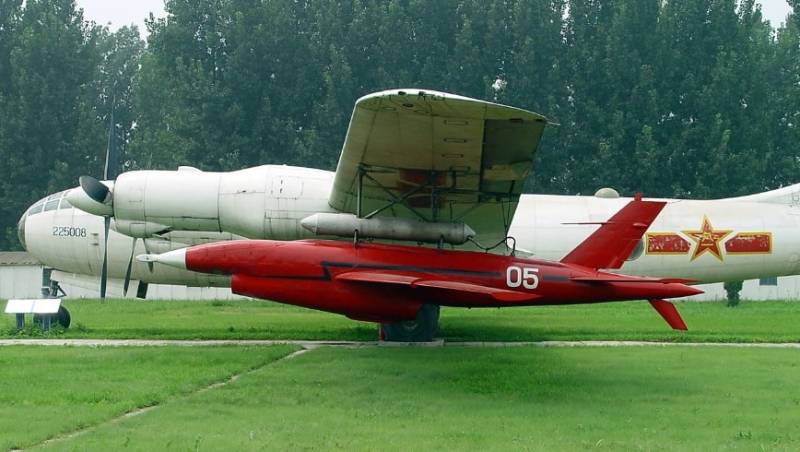
WZ-5 UAV under the wing of the upgraded Tu-4 bomber
Several Chinese Tu-4s were equipped with four AI-20M turboprop engines with a capacity of 4 hp. with. each, which improved the flight performance of remotorized aircraft.
The number of UAVs that the Tu-4 could carry was limited by the dimensions of the WZ-5 reconnaissance vehicle, which had a length of 8,97 m and a wingspan of 9,76 m.
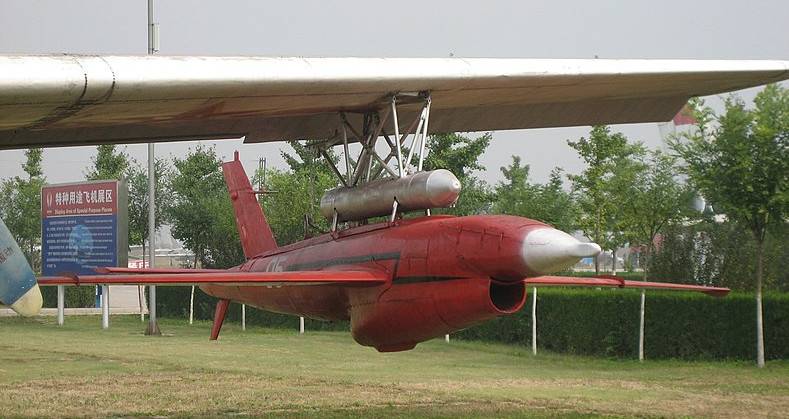
Under the plane of the modernized Tu-4 carrier aircraft equipped with a theater of operations, two WZ-5 drones were suspended. The landing of the UAV was carried out using a rescue parachute system. Once disassembled and prepared, the WZ-5 could be reused. Subsequently, specially modified Shaanxi Y-8E turboprop military transport aircraft (a Chinese copy of the An-12) became carriers of the drones.
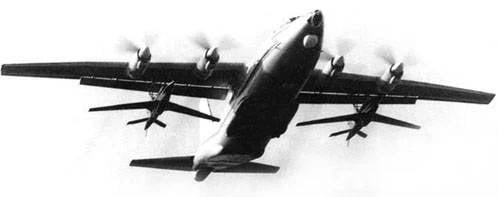
The WZ-5 UAV with a takeoff weight of 1 kg was usually launched in the altitude range of 700-4 m and then climbed to an altitude of more than 000 m, where it could fly at speeds up to 5 km / h. The flight duration was 000 hours.
Chinese reconnaissance drones in the 1980s made regular flights over Cambodia and in areas of Vietnam bordering China. But due to the imperfection of the onboard reconnaissance equipment, the WZ-5 had limited capabilities and could only take photographs during daylight hours.
In addition, the devices, devoid of remote control and flying along a predetermined route using an inertial navigation system, had a significant error in georeferencing and high vulnerability to air defense systems. In this regard, the command of the PLA Air Force insisted on the development of an improved model.
The WZ-5A UAV received a navigation system that works in conjunction with ground-based radio beacons, new photo and video cameras with an IR channel, and an electronic intelligence station. The WZ-5В drone, which was put into service in the early 1990s, was equipped with a radio altimeter and was intended for "deep penetration" into enemy territory. Invulnerability from air defense systems was to be ensured by a low flight altitude (no more than 100 m) and an automatic jamming system.
At present, Chinese UAVs of the WZ-5 family have been converted into targets and are used to train air defense systems and fighter-interceptor pilots.
Chinese UAVs created jointly with Israel
High-ranking leaders of the PLA drew adequate conclusions from the results of the use of Israeli UAVs in Lebanon, considering them to be an inexpensive and quite effective means of armed struggle, which, if used correctly, can have a noticeable impact on the course of hostilities, even when confronted with a technologically advanced enemy.
Already at the end of the 1980th century, China overtook the USSR, and then Russia in the segment of light and middle-class unmanned aerial vehicles, and superiority is still observed. This is largely due to the misunderstanding of the role of drones by the Soviet and Russian generals and the general socio-economic decline that began in the Soviet Union in the mid-XNUMXs.
Success in the creation of UAVs was largely achieved due to the fact that Chinese engineers gained access to advanced Western remote control systems, compact on-board electronics, high-quality optics associated with photo and video recording equipment.
In the late 1980s, the ASN-104 UAV entered service with the PLA. Reconnaissance units equipped with such drones were deployed in areas bordering the USSR and Vietnam.
The ASN-104 UAV, built according to the same scheme as the first Chinese radio-controlled targets Ba-2 and Ba-7, had good characteristics for that time, and was a conglomerate of components and technical solutions created in China and Israel. This drone resembled a miniature overhead wing piston monoplane and was powered by a 28 hp four-cylinder, two-stroke, air-cooled piston engine. with. installed in front of the device. Wingspan - 4,3 m. Length - 3,32 m.
The device with a takeoff weight of 140 kg could conduct reconnaissance at a distance of up to 60 km from the ground station. The fuel tank with a volume of 18 liters was enough for 2 hours of flight. Maximum speed - up to 250 km / h. Cruising - 150 km / h. Ceiling - 3 m. The payload weighing up to 200 kg included photo and television cameras.
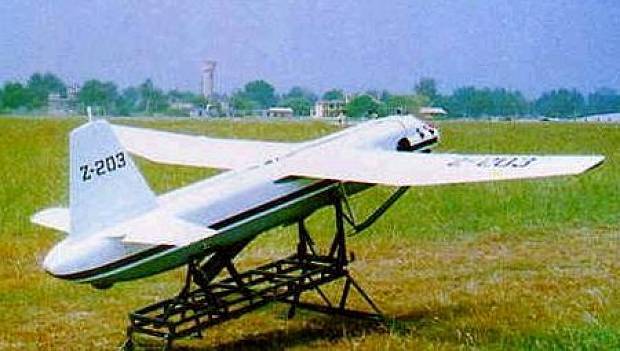
UAV ASN-104
The drone, equipped with an autopilot, remote control systems and equipment for transmitting a television signal at a distance of up to 20 km, was able to operate under the control of a ground station. At a greater distance from the control machine, the flight took place according to a predetermined program. The UAV unit included six drones, three launch devices, a command and control vehicle with remote control equipment and real-time intelligence information reception, as well as a laboratory for processing photographic materials. Subsequently, the ASN-104 drones, which were removed from service, were actively used as flying targets in the process of combat training of anti-aircraft crews, both on land and at sea.
On the basis of the ASN-104 UAV, in the 1990s–2000s, the ASN-105 and ASN-215 devices were created, equipped with more advanced electronics and high-resolution cameras. Thanks to the use of the Beidou satellite navigation system, the accuracy of determining the coordinates of the observed objects has increased, which in turn has increased the efficiency in adjusting artillery fire and issuing target designation of its aircraft. If the drone is used in program mode or if the control channel is lost, it is highly likely to be able to return to the launch point. All reconnaissance information received during the flight was recorded on electronic media. If necessary, instead of visual reconnaissance equipment, an interference transmitter or a VHF radio repeater can be installed.
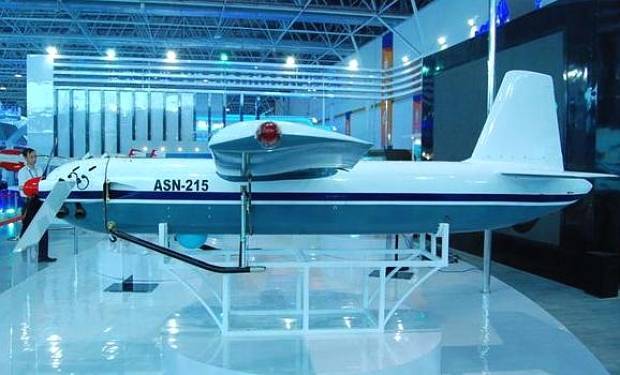
UAV ASN-215
Light class UAVs ASN-105 and ASN-215 were produced in large series and are still in service. They are a good example of the evolutionary improvement of the characteristics of a family of drones, created on the basis of a single platform. These relatively inexpensive and simple devices are intended for use at the divisional and regimental level, mainly for reconnaissance in the enemy's near rear and observation of the front line.
UAV ASN-206, presented in 1996 at the international air show in Zhuhai, is a joint product created by the 365th Scientific Research Institute (a division of Xi'an Northwestern Polytechnic University) and the Israeli company Tadiran.
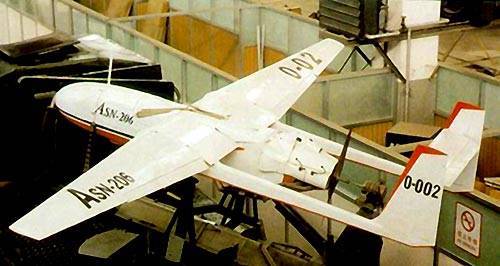
UAV ASN-206
According to the layout scheme, the ASN-206 is a two-beam high-wing aircraft with a pusher propeller that rotates a 51 hp piston engine. with. The choice of this scheme is due to the fact that the rear location of the propeller does not obscure the line of sight of the optoelectronic devices installed in the front of the fuselage.
This device with a maximum takeoff weight of 225 kg has a wingspan of 6 m, a length of 3,8 m. The maximum flight speed is 210 km/h. Ceiling - 6 m. Maximum distance from the ground control station - 000 km. The time spent in the air is up to 150 hours. Payload - 6 kg.
The launch is carried out from a launcher located on a cargo chassis using a solid propellant booster. After completing the flight task, the device descends by parachute.
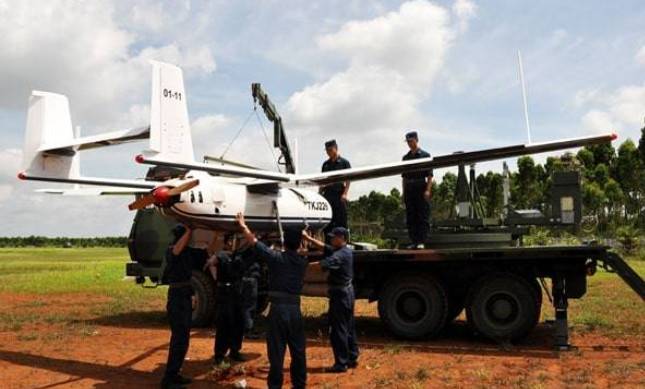
The ASN-206 UAV squadron includes 6-10 drones, 1-2 launch vehicles, separate control, information receiving and processing vehicles, a mobile power source, a tanker, a crane, technical assistance vehicles and vehicles for transporting UAVs and personnel.
Depending on the task being performed, various variants of the ASN-206 can be equipped with a set of high-resolution monochrome and color cameras. The drone has room for three daytime cameras, each of which can be replaced by a thermal imager. In later versions, an optoelectronic reconnaissance and observation system with a laser target designator in a sphere with a diameter of 354 mm, having circular rotation and vertical viewing angles of + 15 ° / -105 °, is installed. The received information is transmitted to the ground station in real time. Alternatively, the drone can be equipped with a JN-1102 jamming station operating in the 30-500 MHz frequency range. The REP station equipment automatically scans the air and suppresses enemy radio stations operating in the VHF band.
UAV ASN-207 (also known as WZ-6) is based on the ASN-206, but has a large size and takeoff weight. ASN-207 entered service in 1999. The device with a take-off weight of 480 kg has a length of 4,5 m and a wingspan of 9 m. The maximum speed is 190 km / h. Ceiling - 6 m. Payload weight - 000 kg. Flight duration - 100 hours. Range - 16 km.
Like the previous ASN-207 UAV model, it is equipped with a combined optoelectronic equipment (“day-night”) mounted on a rotating stabilized platform and a laser rangefinder-target designator. To relay control signals and receive intelligence information at a distance of more than 120 km from the base station, the TKJ-226 repeater drone is used. This device was created on the basis of the ASN-207 UAV airframe and is used with it in one unmanned squadron. Outwardly, this modification differs from the reconnaissance version by the presence of vertical whip antennas.
The flight of the ASN-207 UAV is continuously monitored by two operators located in the mobile control room. One is responsible for the location of the drone in space, the other collects intelligence information.
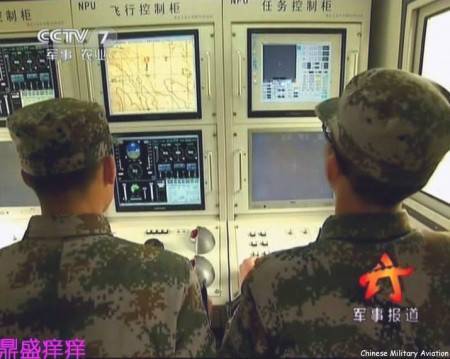
In 2010, images of the ASN-207 modification with a mushroom-shaped radar antenna appeared in the Chinese media, which is used in conjunction with an optical-electronic surveillance system.
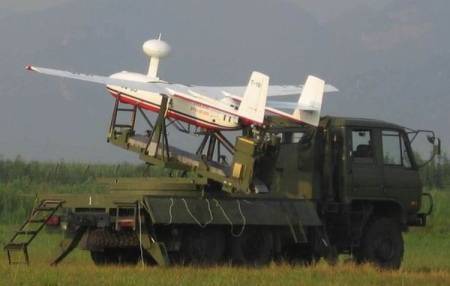
This drone model was designated BZK-006. The characteristics and purpose of the radar are not known, but, most likely, it is intended for reconnaissance of the area in conditions of poor visibility. Since the installation of a massive radar radome increased drag, the duration of the flight of the BZK-006 UAV is 12 hours.
The modification of the ASN-207 UAV, designed to suppress VHF radio networks, has the designation RKT164. This drone is equipped with jammers and additional antennas.
At the air show in Zhuhai, held in 2010, a strike modification, known as DCK-006, was demonstrated. Under the wing of the drone there are hardpoints on which four miniature laser-guided missiles can be placed.
An intermediate position in terms of weight and dimensions between the ASN-206 and ASN-207 UAVs is occupied by ASN-209. The device is designed to monitor the battlefield, search for and track ground targets, control artillery fire and patrol.
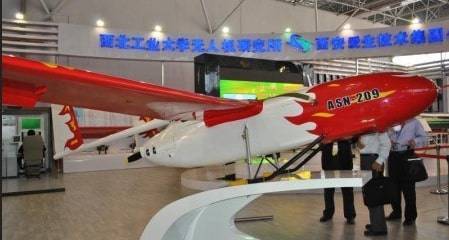
UAV ASN-209
This model is 4,273 m long, with a wingspan of 7,5 m, and has a takeoff weight of 320 kg. With a payload mass of 50 kg, the drone can operate at a distance of 200 km from the control station and stay in the air for 10 hours. The maximum flight altitude is 5 m. The unit consists of two unmanned aerial vehicles and three vehicles with a launch ramp, a control post and support facilities.
Unlike the ASN-206 and ASN-207, which have become widespread in the PLA, the ASN-209 UAV was intended from the very beginning for foreign buyers. According to Chinese sources, the export value of the ASN-209 is about 40% less than similar class drones built in Israel and the United States. It is currently known that two dozen drones of this type were purchased by Egypt. One of the terms of the deal was the transfer of Chinese technology and assistance in establishing the production of drones at Egyptian enterprises.
In addition to medium-range drones, Israel has assisted China in the development of light near-field UAVs designed for daytime visual reconnaissance.
The first joint Chinese-Israeli device of this class was the ASN-15, which entered the army in 1997 and demonstrated to the general public in 2000.
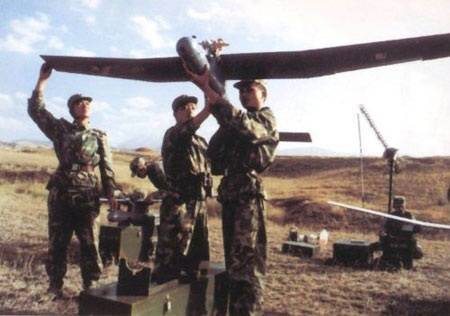
PLA soldiers prepare to launch ASN-15 UAV
When creating the ASN-15 UAV, the airframe and propulsion system of the Chinese ASN-1 drone, which was not accepted into service, was used, the main flaws of which were insufficiently perfect control equipment and the poor quality of the transmitted television picture.
ASN-15 is equipped with a miniature TV camera of a new generation and a fairly powerful TV signal transmitter. The ASN-15 UAV is capable of staying in the air for about an hour, at a distance of up to 10 km from the ground control point. A miniature two-stroke gasoline engine provided a maximum speed of up to 80 km / h. Ceiling - 3 km. Wingspan - 2,5 m. Length - 1,7 m. Due to the location of the engine and propeller on the upper part of the wing, landing is made on the fuselage.
A further development of the ASN-15 light UAV was the ASN-217. This device is equipped with more advanced observation equipment, and the propeller rotates an electric motor powered by a battery.
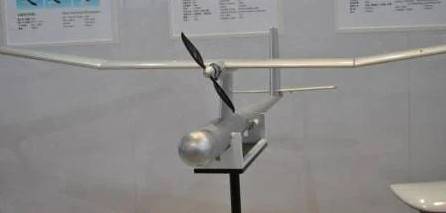
UAV ASN-217
The ASN-217 UAV has a takeoff weight of 5,5 kg. In horizontal flight, it can accelerate to 110 km/h, cruising speed - 60 km/h. The time spent in the air is up to 1,5 hours. The distance from the ground station is up to 20 km.
In 1995, Israeli "kamikaze drones" of the Harpy family appeared at the disposal of the PLA. The first samples of "killer drones" of this family were designed by Israel Aerospace Industries in the late 1980s. The Israelis managed to create a compact and relatively inexpensive drone capable of striking ground targets.
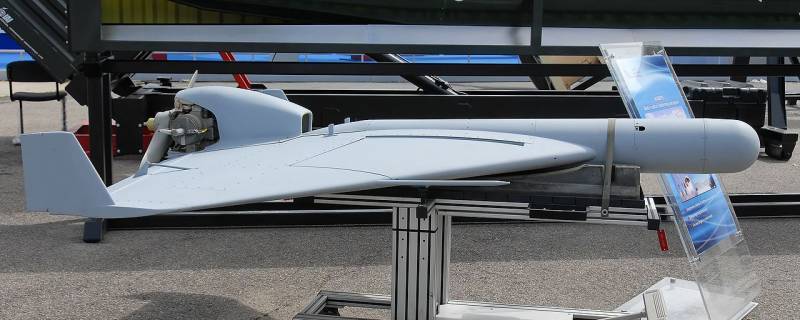
UAV Harpy
The Harpy UAV is made according to the “flying wing” scheme. An internal combustion engine with a capacity of 37 liters is placed in the tail section of the apparatus. with. with push screw. "Harpy" carries a high-explosive fragmentation warhead weighing 32 kg and is equipped with an autopilot and a passive radar homing head. The length of the device is 2,7 m, the wingspan is 2,1 m. The take-off weight is 125 kg. Speed - up to 185 km / h, with a flight range of 500 km.
The launch is carried out from a container launcher using a powder charge, return and reuse is not provided. After the launch, the drone enters the patrol area, after which the passive radar seeker is turned on and a search is made for enemy ground-based radars. When high-frequency radiation is detected, the drone automatically aims at the source and hits it with an explosion of the warhead. Unlike anti-radar missiles, the Harpy can stay in the desired area for several hours and wait for the signal of the target. At the same time, due to the relatively low RCS, the detection of the Harpy by radars is difficult.
In 2004, Chinese representatives announced their intention to conclude another contract for the supply of a new batch of advanced Hapry-2 "kamikaze drones" and the modernization of Israeli Harpies already acquired. However, the United States opposed this, after which the PRC was denied the sale of new loitering ammunition and the modernization of those delivered earlier. However, by that time, the Chinese industry had reached a level where it became possible to create such products on their own.
The Chinese version of the "killer drone" was designated JWS01. It is generally similar to the Israeli "Harpy", but has a number of differences. For the Chinese loitering munition, designed to destroy air defense systems, there are two types of interchangeable seekers operating in different frequency bands, which significantly expands the range of potential targets. UAV JWS01 after launch is completely autonomous and performs the flight in accordance with a pre-set program.
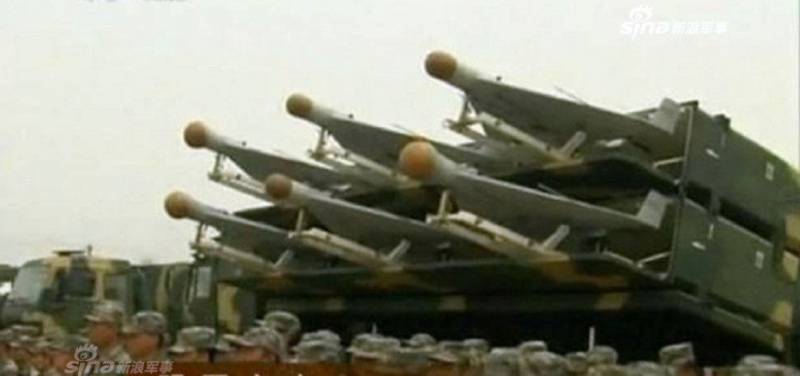
JWS01 mobile launcher
A mobile launcher on an off-road truck chassis carries six JWS01s. The unit includes three self-propelled launchers, an electronic intelligence station and a mobile command post.
At the exhibition of weapons and military equipment IDEX 2017, which was held in February 2017 in Abu Dhabi, an improved model ASN-301 was presented. Additional antennas are installed in the lower and upper parts of the fuselage of the modernized kamikaze drone, which, according to experts, allows you to remotely correct the actions of the drone.
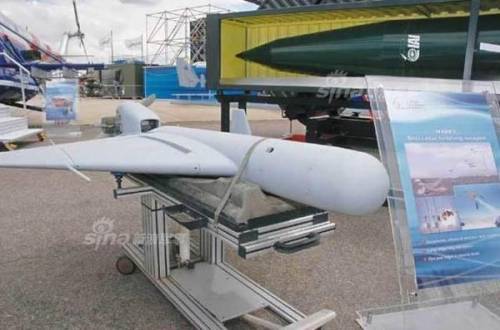
Loitering ammunition ASN-301
According to information published in the Chinese media, the ASN-301 loitering ammunition weighs 135 kg, has a length of 2,5 m and can stay in the air for up to 4 hours. Flight speed - up to 220 km / h. The ASN-301 passive radar homing head operates in the 2-16 GHz frequency range and has a search range of 25 km. When a warhead is detonated, about 7 fragments are formed with a continuous destruction zone of 000 m.
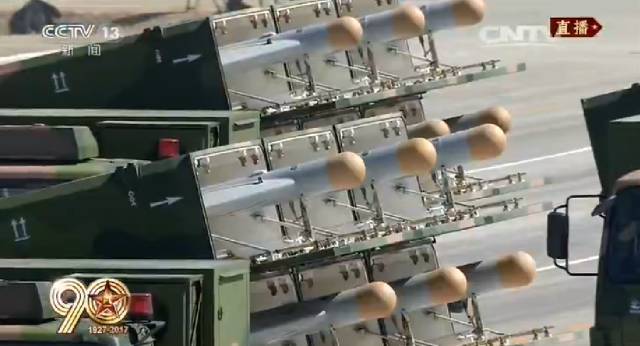
At the military parade in honor of the 90th anniversary of the PLA, a 9-charge mobile launcher ASN-301 was demonstrated, which differs from the JWS01 in the presence of three additional launch containers.
Thus, it can be stated that thanks to copying foreign samples and cooperation with foreign companies, the PRC has created a backlog that has now made it possible to fully equip the People's Liberation Army of China with unmanned aerial vehicles designed for reconnaissance and surveillance on the battlefield and in the near rear of the enemy. , as well as loitering ammunition.
Information